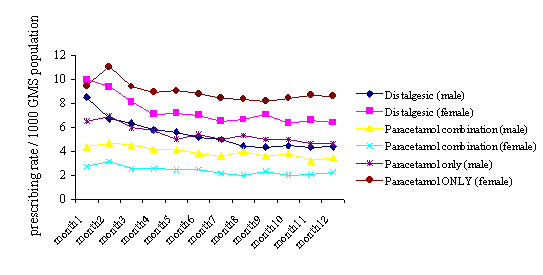| pA2 online © Copyright 2004 The British Pharmacological Society |
176P
University of Newcastle Winter Meeting December 2004 |
Prescribing patterns for distalgesic in general practice in Ireland C. Usher1, B. Mcgowan2, M. Teeling1, K. Bennett1 & J. Feely1. 1Department of Pharmacology and Therapeutics, Trinity Centre and 2National Centre for Pharmacoeconomics, St James’ Hospital, Dublin 8, Ireland. |
|
Distalgesic® is an analgesic combination product (composed of the opiate dextropropoxyphene in combination with paracetamol) which is indicated for the management of mild to moderate pain. Its use as an analgesic for the management of acute pain is controversial as it has been suggested that the combination is no more effective than use of paracetamol alone [1]. Moreover, its use in the elderly is regarded as potentially inappropriate. The aim of this study was to compare the prescribing patterns of Distalgesic® with that of paracetamol alone/other paracetamol-containing combinations.
A national prescription database of all patients was examined to determine total numbers of prescriptions dispensed and corresponding ingredient cost for the compound analgesic preparations for Ireland from January 2002–December 2003. In order to investigate more closely, patterns of usage, patients (from the Eastern Region Health Authority) who were new to any therapy (specifically Distalgesic, paracetamol or paracetamol combinations) between January and June 2002 were identified as follows: they had not received analgesic medication in the 6 months prior to initiation of therapy, to be included in the cohort for study (n = 29 135 patients). Follow-up data were available for 12 months from the month of initiation of therapy. Patients who received a prescription for both Distalgesic and paracetamol and/or paracetamol combinations, or switched between analgesics, during the 12 month follow-up period were excluded. Prescribing trends for 12 months from the month of initiation of therapy in the over 65 year olds are presented. Duration of therapy and the number of prescriptions received post initial prescription, were also analyzed (for all ages). All statistical analysis was carried out using SAS Version 8.0.
Results showed that Distalgesic is the market leader accounting for 42% of the prescriptions dispensed for the compound analgesics in Ireland in the year 2003 (total cost €0.6m; total number of prescriptions 366 212). With regard to patients new to therapy, Distalgesic was used at a comparable rate with that of paracetamol in both male and female patients and was also used at a relatively high rate in those aged over 65 years ( Figure 1 ). Long-term use of the three compound analgesics was uncommon with 50-60% receiving only 1 month’s prescription.
Distalgesic prescribing in Ireland features prominently as a percentage of all compound analgesics prescribed, with relatively higher prescribing rates noted in female and elderly patients. The results may indicate inappropriate use in general practice.

Figure 1 Comparison of Distalgesic, paracetamol and paracetamol combination prescribing in patients over 65 years in the ERHA 12 months post initiation of therapy
1. Anonymous. Drug and Therapeutics Bulletin 1998; 36: 80.